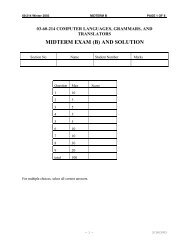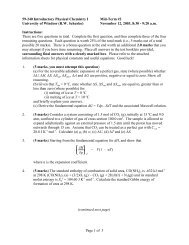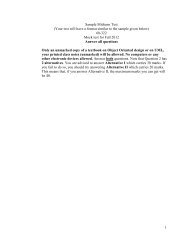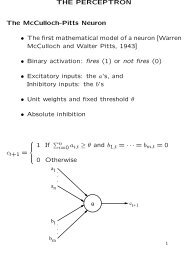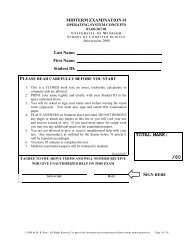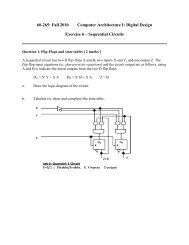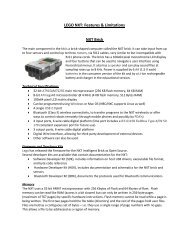LEGO NXT: Features & Limitations
LEGO NXT: Features & Limitations
LEGO NXT: Features & Limitations
Create successful ePaper yourself
Turn your PDF publications into a flip-book with our unique Google optimized e-Paper software.
The leJOS NXJ firmware is written in a combination of C and ARM assembler code. It consists of theinitialization code, the Java VM and device drivers for all the hardware subsystems. The leJOS firmwareis a complete firmware replacement and has no reliance on the standard <strong>LEGO</strong> firmware. The first 32kbof flash memory is allocated to the leJOS NXJ firmware. Most code is executed from flash memory, but asmall amount (e.g. the code that writes pages of flash memory) is copied to RAM. Read-only data is heldin flash memory but read/write data is copied to RAM. The firmware uses a fixed size stack and interruptstack.The leJOS NXJ Java VM executes one Java program at a time. This can either be a user program or theleJOS start-up menu. One Java program can execute another. When this is done the first Java program isremoved from memory, and the second one is then executed. This is how the start-up menu executesuser programs.The start-up menu occupies up to 48kb of memory that starts at address 32k (i.e. after the end of thefirmware). The last word of the 48kb allocated to the start-up menu holds the size of the start-up menu).Java programs execute from flash memory. Static read-only data is held in flash memory. Static readwritedata is copied to RAM. Objects are created in a heap that starts at the top of the RAM and growsdownwards. The Java stack starts at the bottom of free RAM memory and grows up. A garbage collectorfrees memory used by un-referenced objects when the heap becomes full.The maximum filename length is 20 characters. If the average filename length is 15 characters, only 10files can be supported. This limitation is not checked, and will cause an exception when the file tablebecomes full. Also, only one file can be open at a time.Power SupplyPower is supplied to the <strong>NXT</strong> using 6 AA/LR6 batteries or a rechargeable battery pack with a poweradapter plug (120VAC 60Hz). The rechargeable battery pack takes up more physical space than 6 AAbatteries. The <strong>NXT</strong> comes with a cover that sits flush with the <strong>NXT</strong> unit while the rechargeable batterypack protrudes almost a centimetre out from the <strong>NXT</strong> brick. When one builds a robot from existingbuild instructions, this will have to be taken into account.When charging the <strong>NXT</strong>, the green indicator light turns on. When the battery is recharging, the red lightis on. A fully charged battery requires approximately four hours. The <strong>NXT</strong> can be used when the batteryis recharging; however, recharging then requires more time. The Li-Ion Polymer battery can berecharged up to 500 times.There is a difference in performance (power and time) when it comes to using 6 AA’s vs. therechargeable battery pack. 6 AA’s will provide more power to the <strong>NXT</strong> motors than the Li-Ion batterypack will. In fact, in competitions, the preferred choice is Energizer Lithium batteries over conventionalalkaline batteries, when power is of the utmost importance. Although the Li-Ion battery pack providesless power than 6 AA’s, it delivers more steady power over a longer period of time.It is difficult to quantify the time it takes to fully discharge the alkaline batteries or the Li-Ion batterypack. This depends on what types of tasks the <strong>NXT</strong> is performing (all motors turning at full speed, or justdata calculations). One thing is for certain, as the batteries begin to deplete, the power of the motorsbegin to deplete as well.






